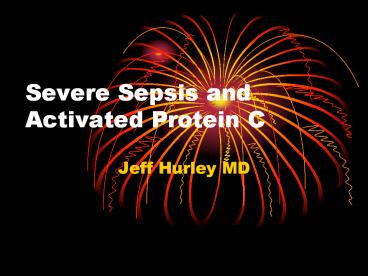Severe Sepsis and Activated Protein C - PowerPoint PPT Presentation
Title:
Severe Sepsis and Activated Protein C
Description:
Severe Sepsis and Activated Protein C Jeff Hurley MD Perspective Most common cause of death in medical and surgical ICUs (20-60%). Approximately 225,000 cases of ... – PowerPoint PPT presentation
Number of Views:127
Avg rating:3.0/5.0
Title: Severe Sepsis and Activated Protein C
1
Severe Sepsis and Activated Protein C
- Jeff Hurley MD
2
Perspective
- Most common cause of death in medical and
surgical ICUs (20-60). Approximately 225,000
cases of sepsis which are fatal annually. - Sepsis Syndrome represents a systemic
inflammatory response to various insults. - Severity is determined by alteration in normal
physiological parameters, etiology, and response
to treatment
3
Spectrum
SIRS Severe Clinical insult manifested by 2 or more of the following Temperature gt 38C or lt36C Tachycardia gt 90 beats/minute Respiratory rate gt 20 or PaCO2 lt 32 mm Hg White blood count gt 12,000 or lt 4,000 or gt 10 Bands
Sepsis SIRS due to an infection (known or suspectednot obligatory). Considered SEVERE if hypotension or systemic manifestations of hypoperfusion (lactic acidosis, oliguria, changes in mental status, ARDS, hypoxemia PaO2 lt 72 on RA) is present.
Septic Shock Sepsis induced hypotension (SBP lt 90, reduction of gt 40 mm Hg from baseline) despite adequate fluid resuscitation that requires pressors to maintain normotension, along with perfusion abnormalities that may induce lactic acidosis, oliguria, or changes in mental status.
MODS The presence of altered organ function in an acutely ill patient such that homeostasis cannot be maintained without intervention.
4
Pathophysiology
- Normal responses to insults result in the
development of - Inflammatory response
- Thrombotic response
- Anti-Fibrinolytic response
5
Pathophysiology
- Infectious process
- Mobilization of PMNs and Monos
- Creation of inflammatory cytokines triggering a
casade. Noteably IL-1, TNF, IL-6. - Innappropriate regulation or ongoing stimulation
of pathway (LPS, peptidoglycan, lipotoeichoic
acid, super antigens) - Resulting in Sepsis
6
(No Transcript)
7
Treatment
- Many therapeutic interventions have been
attempted. - Anti-endotoxin
- Mabs against TNF
- Bradykinin antagonists
- PAF antagonists
- Prostaglandin antagonists
- IL-ra
- None have shown a benefit over placebo.
8
Activated Protein C
- Protein C is a vitamin K dependent endogenous
protein that is a regulator of the inflammatory,
coagulation, and fibrinolytic pathways. - Under normal conditions, the generation of
Thrombin (IIa) is balanced by the combination of
thrombin with thrombomodulin. This combination
converts the inactive precursor to the activated
from of the protein. Evidence suggests that in
sepsis, then is a cytokine induced decrease in
thrombomodulin. - APC then degrades factors VIIIa and Va, both
cofactors in the coagulation cascade. Hence, APC
acts as an antithrombotic. - APC, through decreased Thrombin levels, decreases
the release of Plasminogen activator inhibitor-1
resulting in an increase in plasmin generation.
Hence, APC acts an a pro-fibrinolytic. - APC, through in vitro studies, has also shown to
decrease the production of inflammatory cytokines
such as IL-1, IL-6, and TNF. Hence, APC acts as
an anti-inflammatory. Also shown to decrease
selectin-mediated adhesion. - Other avenues Factor XII activation leads to
kallikrein activation. Kallifrein then cleaves
kininogen to the vasoactive peptite bradykinin
which has been related to the iNOS (inducible
nitric oxide system) system. - Sepsis also is suspected to alter mitochondrial
function.
9
Study Summary
- Randomized, double-blinded, placebo-controlled,
multicenter trial. - 1690 enrolled patients
- Inclusion criteria 3 out of 4 SIRS plus 1 out
of 5 of the following - Hypotension unresponsive to fluids
- Oliguria
- ARDS criteria Pao2 to FiO2 lt 250
- Hematologic disorder platelets lt 80,000 or 50
decrease in 3 days - Metabolic acidemia lt 7.30 or base deficit gt 5
with plasma lactate gt 1.5 normal levels - Exclusion criteria Pregnancy, age lt18,
Platelets lt 30,000, conditions that increased
risk of bleeding, others. - Randomized to APACHE II
- Measure Survival at 28 days.
- Delivery 96 hour infusion of APC at 24 ug/kg/hr.
No dosage adjustment of age, gender, hepatic or
renal dysfunction.
10
Results
- Study stopped early.
- Relative risk reduction of 19.4 with an absolute
reduction of 6.1 - Number needed to treat 16.4
11
Physiology
- Reduction in D-Dimer, a measure of intravascular
thrombus formation. - Reduction in IL-6 levels.
12
Complications
- Bleeding was the most serious complication 3.5
in study group versus 2.0 in placebo. - Occurred predominately in those predisposed to
bleeding. - 1 serious bleeding event for every 66 patients
treated. - Contraindications Internal bleeding, recent
hemorrhagic stroke, recent brain surgery or
severe head trauma, trauma, epidural catheter,
intracranial neoplasm or mass lesion. - Predisposed INR gt 3.0, platelets lt 30,000,
heparin infusion, recent GI bleed, recent
thrombolytic use, recent G IIb/IIIa inhibitors,
recent aspirin or other antiplatelet, recent
ischemic stroke, AVM or aneurysm, severe hepatic
disease.
13
Legal Isssues in Sepsis
- Failure to recognize SIRS criteria or potential
sources of infection. - Failure to take unstable patients to surgery to
treat infectious processes. - Insufficient fluid resuscitation or failure to
institute vasoactive drugs or mechanical
ventilation. - Incorrect sequence of pressors such as single use
epinephrine that impairs splanchnic blood flow
and perfusion. - Excessive use of pressors to supranormal cardiac
output that has shown to increase morbidity and
mortality. - Administration of bicarbonate therapy that
worsens intracellular acidosis.
14
Summary
- APC (drotrecogin alfa) indicated for the
reduction of mortality in Severe Sepsis who have
a high risk of death. - Absolute reduction in mortality of 6.1
- Standard of Care?































